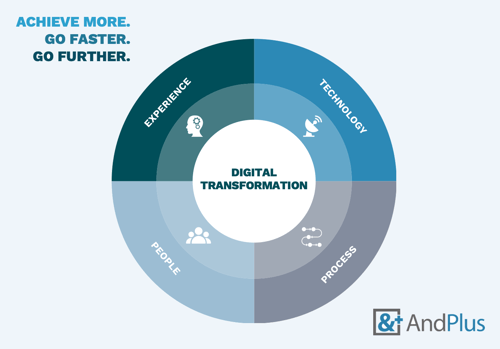AndPlus acquired by expert technology adviser and managed service provider, Ensono. Read the full announcement
AndPlus acquired by expert technology adviser and managed service provider, Ensono. Read the full announcement
The world of business is rife with new terminology. Among the latest in the long parade of business buzzwords is “digital transformation."

While the origin of the term is obscure, digital transformation initiatives are increasing in companies around the world, from 100-year-old international conglomerates to “born digital” startups that have, and presently are, transforming industries and markets.
This movement and adoption of the term may rise from the constant and increasing pressures that businesses face every day:
In response to these pressures, organizations are increasingly focusing their attention on digital transformation. Given this trend and the significant impact organizations can experience through digital transformation, this document will explore key aspects, important considerations, and additional resources regarding digital transformation and its business application.

As traditionally understood, the notion of “digital transformation” means taking business processes (or entire business models) and reinventing them from the ground up on a foundation of digital technology—that is, technology driven by computers, networks, and data.
As a textbook definition, that’s pretty abstract, and necessarily so, because what it means for a business model or process to be “digitally transformed” has changed over the years as new technologies have left the drawing board and presented a reasonable return for the businesses who invest in them. Fifteen years ago, for instance, “mobility” wasn’t a part of any company’s digital transformation, but since that time, mobility has radically altered nearly every industry, from transportation and manufacturing to healthcare, leisure, and entertainment.
So, in the interest of putting a stake in the ground, AndPlus defines “digital transformation” as organizational change through the use of digital technologies and business models to improve business performance and deliver new levels of customer value.
Given this definition, digital transformation can take many forms. Here are just a few examples to illustrate:
In addition, digital transformation spans all industries. Two relevant and well-known examples include:
Transportation - For decades, taxis were dispatched by humans. They took phone calls and radioed the requests to taxi drivers, hoping one would be available in the area. Uber and Lyft eliminated both the phone call and the uncertainty of service delivery with a system that directly matched ride requests with available drivers, relying heavily on the geolocation data provided by both riders’ and drivers’ mobile devices. The increased quality of service and reduced costs afforded by this digital transformation have changed the customer’s expectations and shaken the traditional taxi industry.
Food Services - Food delivery has also been digitally transformed. By enabling online food ordering, order accuracy has increased, and third-party delivery services such as Doordash® and Postmate™ have eliminated the need for restaurants to employ on-staff drivers. (The related costs for vehicles, insurance, and maintenance are also lowered or eliminated.). This digital transformation has been a huge win for all stakeholders.
(You can read about other impacts and examples of digital transformation here.)
To gain a clearer understanding of digital transformation we can compare it to digital strategy – something we are more likely to be familiar with. While these terms may appear to synonymous, they are not. Their comparison will not only help to clarify what digital transformation is, but also shed light on why some digital transformation efforts have historically fallen far short of their expected results.
Unlike digital strategy, digital transformation involves a complete top-down approach - from senior management to the hands-on employee.  Unlike digital strategy, transformation is a long-term, iterative process. Think of digital transformation as more of a journey than destination.
Unlike digital strategy, transformation is a long-term, iterative process. Think of digital transformation as more of a journey than destination.
Using theses comparisons, we see that many companies use digital technology to improve business processes and capabilities. Leveraging hardware, software, algorithms, and the internet, it's 10 times cheaper and faster to engage customers, create offerings, harness partners, and operate your business. Those are good things for digital strategies to accomplish.
However, digital “natives” like Amazon and Tesla and innovative giants like Disney and Siemens have embraced a much larger digital transformation approach to business. They have created or embraced new business processes, ways to communicate, new business offerings using a holistic new approach to their business – effectively deploying digital's new rules of business.
While these comparisons help to illustrate what digital transformation is, the definition is open for some discussion, even among the “expert” technology analyst groups such as IDC, Forrester, and Gartner. Despite their subtle differences, one thing that even the experts can agree on is that digital transformation can have profound and positive impacts on businesses and even entire industries.
One of the biggest mistakes a business can make is to assume today’s success will be there tomorrow. A company can thrive for generations, relying on a tried-and-true formula for success but it’s easy to fall into the trap of believing that what has always worked in the past will always continue to work in the future. Unfortunately, nothing can be farther from the truth.
In fact, the rate of change and business evolution is illustrated in a quote from John Marchante, Global Chief Information Officer for Vanguard Investment Management company, “Just look at the S&P 500. In 1958, U.S. corporations remained on that index for an average of 61 years, according to the American Enterprise Foundation. By 2011, it was 18 years. Today, companies are being replaced on the S&P approximately every two weeks. Technology has driven this shift, and companies that want to succeed must understand how to merge technology with strategy.”
All it takes is one disruptive technology, one upstart company that comes out of nowhere with a better, faster, cheaper, more convenient way to deliver the same products and services, to completely upend an established company’s entire business model.
So why do businesses want to undertake digital transformations? The answer is different for each business, but the most common motivations fall into several categories:
The concept of digital transformation and has certainly gained momentum as evidenced by the IDC Worldwide Semiannual Digital Transformation Spending Guide forecast that estimates worldwide technology and services spend that enables digital transformation will reach $1.97 trillion in 2022. IDC predicts that digital transformation spending will grow steadily, achieving a five-year compound annual growth rate of 16.7 percent between 2017 and 2022.
As with any investment, the question of measuring ROI and quantifying success is a requirement, but in the case of digital transformation, that quantification may be more difficult than first expected.
Regardless of digital transformation’s ROI measurement challenges, it is important to establish the metrics of success. These should not only include traditional financial and business metrics but also should include the measurement of business outcomes including:
Because digital transformation crosses multiple organizational boundaries and its timeframe extends beyond short-term digital projects, traditional business value calculations may be less effective than expected and a longer-term portfolio view is likely to be more realistic approach to establishing value. However, the success of multiple shorter-term digital projects that comprise the portfolio of digital transformation can be measured as indicators of the longer-term digital transformation process.
Achieving meaningful success in the digital transformation journey is dependent on more than just tools, technology, and infrastructure. Digital transformation is a process that challenges every employee to think differently about their job, their relationship with their “customer”, and the processes and tools they use.
Culture
“Culture” is how people and groups within the organization think about themselves and each other. For a digital transformation initiative to succeed, an organization needs a conducive culture, with multiple characteristics:
Organizational Qualities
“Organizational qualities” relates to how the company, as a whole, studies a problem and reaches a solution.
With the optimal culture in place, organizational qualities that are essential to the success of a digital transformation can be fostered. Two of the most important organizational qualities for a successful digital transformation are creative-thinking and design-thinking.

Tools and Technologies
Digital transformation, by definition, involves the application of digital technologies to enable business transformation. Therefore, tools and technologies are important to the success of a digital transformation initiative, and should have certain critical characteristics:
In addition, digital infrastructure can be highly important to digital transformation’s results. Does the organization have the computing resources on-site to implement a digital solution? If the design involves offloading the computational heavy-lifting to cloud-based services, is there sufficient network bandwidth to support the communication with the cloud services across the internet? Would it be advantageous to implement edge computing resources to reduce bandwidth requirements? Answers to these questions, among many others, are important to making digital transformation a success. It’s not just about the software.
Don’t Forget the People
While the opportunities for success are great, the challenges of successful digital transformation extend beyond just technology. An effective approach to digital transformation must start with the mindset of every employee and include the need to optimize their productivity. Peter Drucker addressed this fact when he said: “The most important, and indeed the truly unique, contribution of management in the 20th century was the fifty-fold increase in the productivity of the manual worker in manufacturing. The most important contribution management needs to make in the 21st century is similarly to increase the productivity of knowledge work and knowledge workers.”
To meet this challenge, we also need to address how digital transformation enables teams to work together throughout the enterprise using new technologies, processes and tools. Only then can we expect to receive a return on our digital transformation investments and enable our employees to focus on what we actually hired them to do: dream, create, and innovate.
Listen to Angela Spencer, our SVP of Digital Transformation chat about the "Strategy-Execution Gap"
By some estimates, more than half of all IT projects fail.
Digital Transformation is a high stakes game. The survival of some organizations depends on a successful transformation, but these projects can be more complex than typical IT projects because they require a complete re-thinking of many business practices. The reasons why digital transformation projects fail can be divided into just a few main categories: technology, project management and organizational culture.
What can you do to ensure a successful transformation?
You can find information and insight on a wide range of topics from transformation leaders on our "Resources for Transformation Leaders" page.
Remember, digital transformation is about far more than just technology.

Increasingly, companies realize that their existing business models and processes are holding them back and causing them to fall behind in the competitive race. For these companies, digital transformation offers the possibility of creating top-down, organizational change that leverages digital technologies and business models to improve business performance and deliver new levels of customer value.
At AndPlus, that’s what we do. We’re a digital product development agency that applies technologies to create or improve experiences, processes, and products.
For more than a decade, our teams of builders, innovators, engineers, and designers have delivered business transforming digital products that work the boundaries of mobile, web, IoT, firmware, and advanced technologies including data warehousing, machine learning, AI, and big data.

Driven by a passion for excellence, AndPlus creates digital transformation strategies and reliable digital products that also deliver exceptional user experiences. Our deep expertise and custom Agile process enable AndPlus to iterate quickly, provide transparency, and deliver on time and on budget — helping our partners get to market faster with less risk.
Put simply, we’re here to guide and assist your organization in its digital transformation journey by delivering the best strategies, expertise, processes, and technology.
Give us a call and let’s get started.
AndPlus is a digital transformation agency that applies technologies to create or improve experiences, processes, and products. For more than a decade, our teams of builders, innovators, engineers, and designers have worked the boundaries of mobile, web, IoT, firmware, and advanced technologies including data warehouse, machine learning, AI, and big data.
Put simply, we’re here to guide and assist your organization in its digital transformation journey by delivering the best strategies, expertise, processes, and technology.
Give us a call and let’s get started.








or If you don't like forms, email us info@andplus.com
Read the AndPlus ratings and client references on Clutch - the leading data-driven, B2B research, ratings, and reviews firm.
257 Turnpike Road, Southborough, MA
508.425.7533
257 Turnpike Road, Southborough, MA
508.425.7533